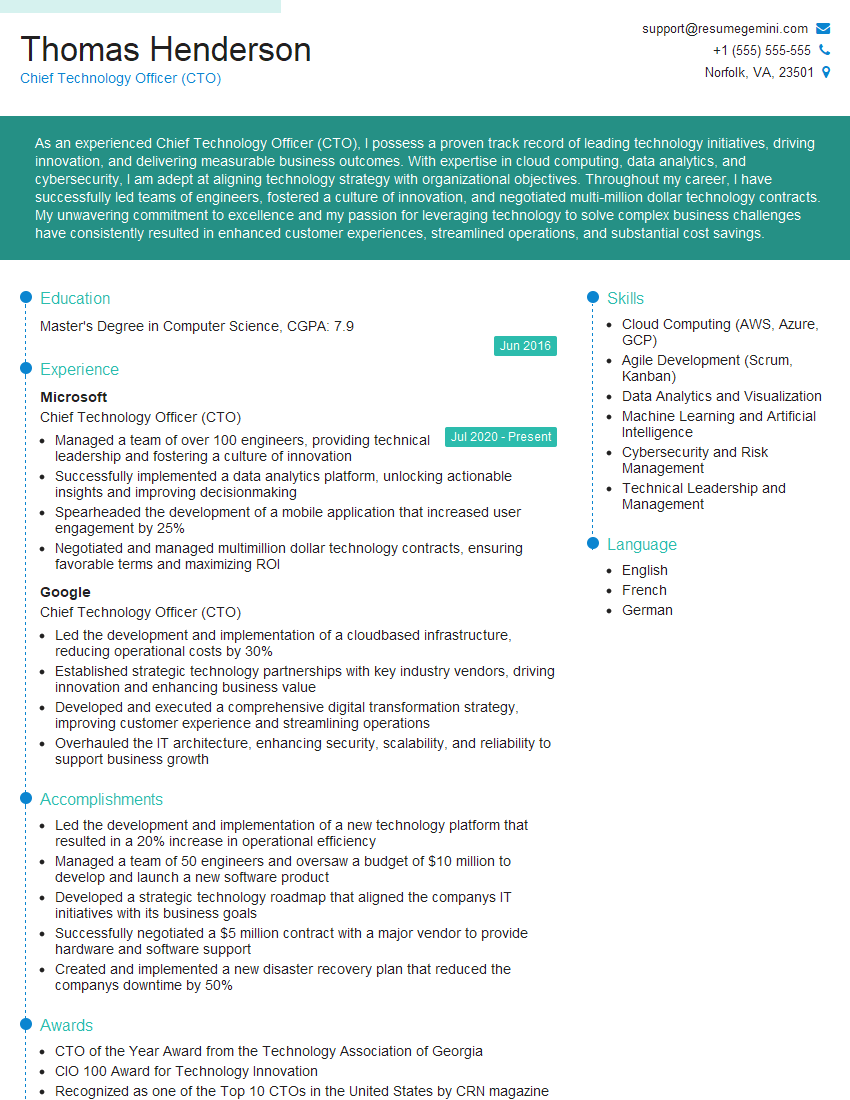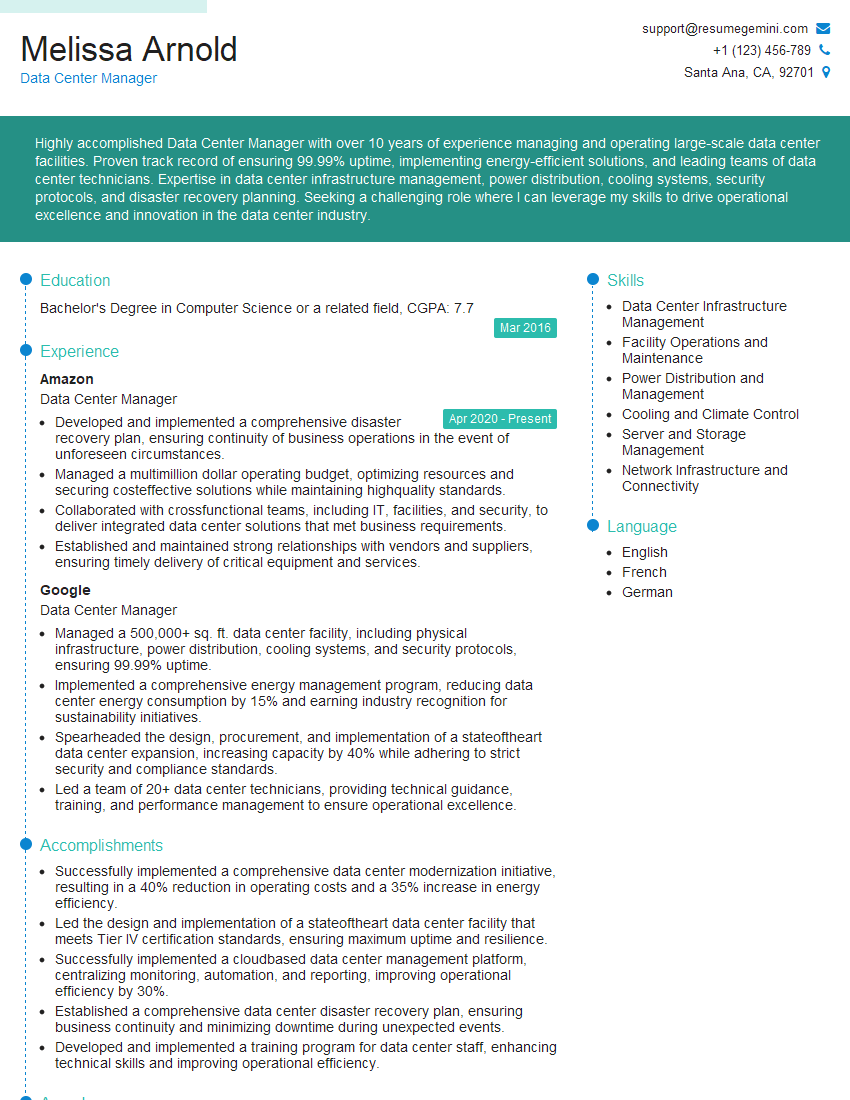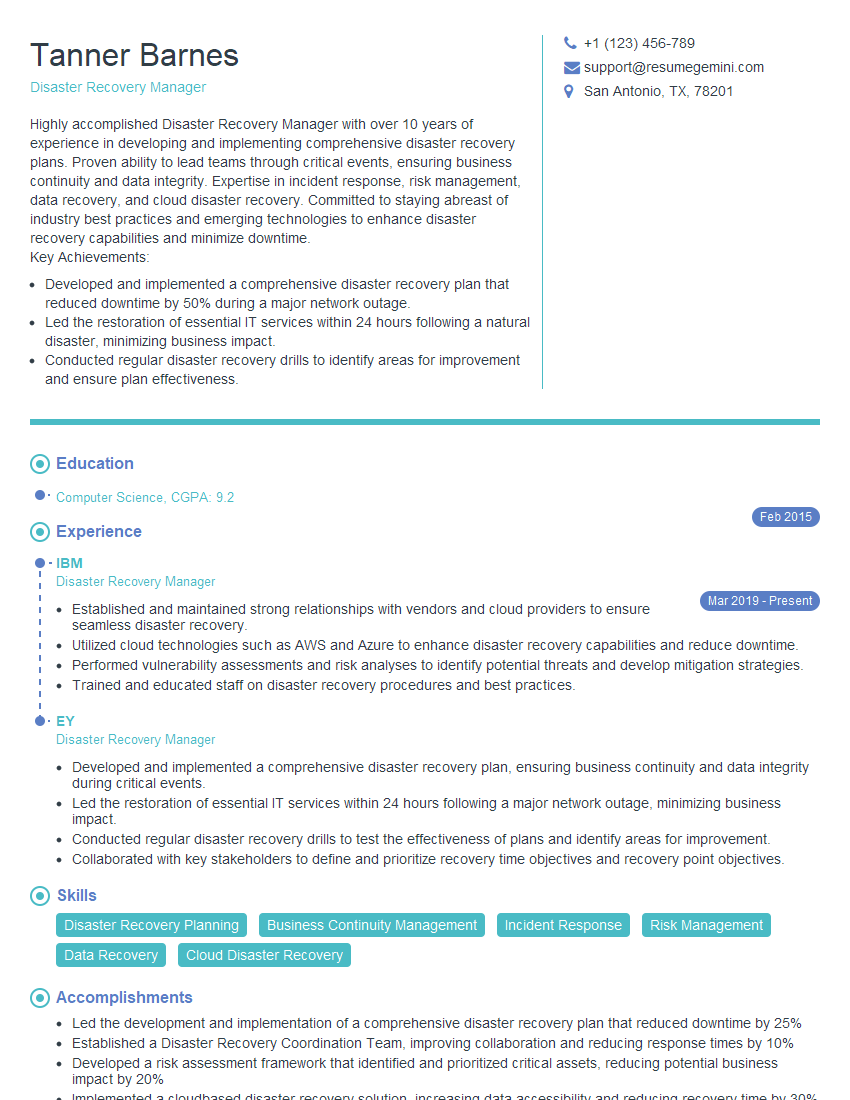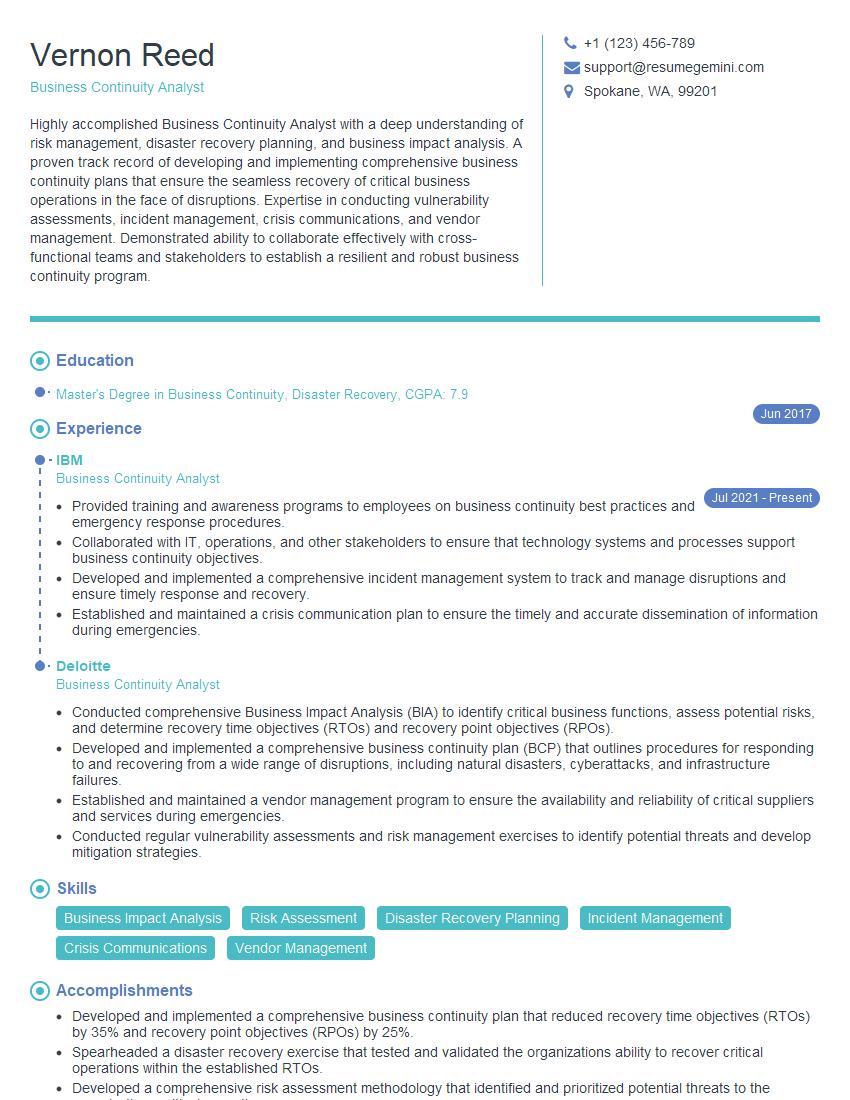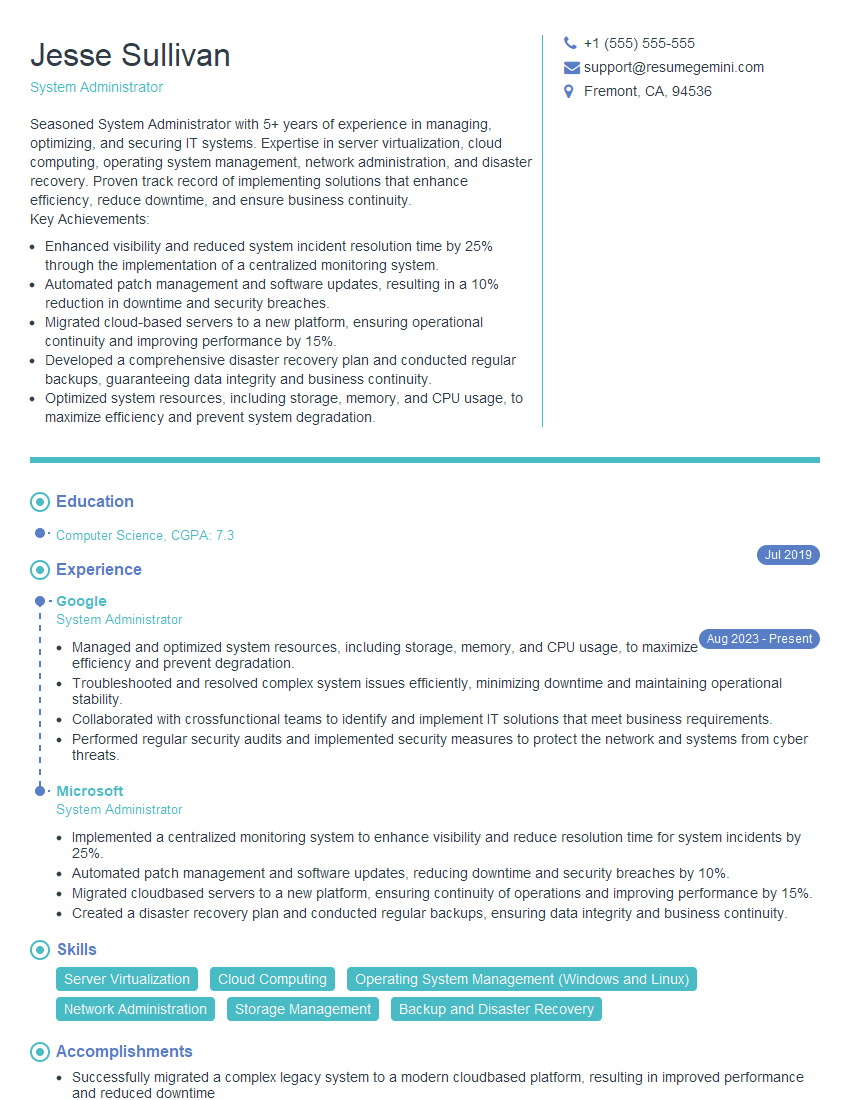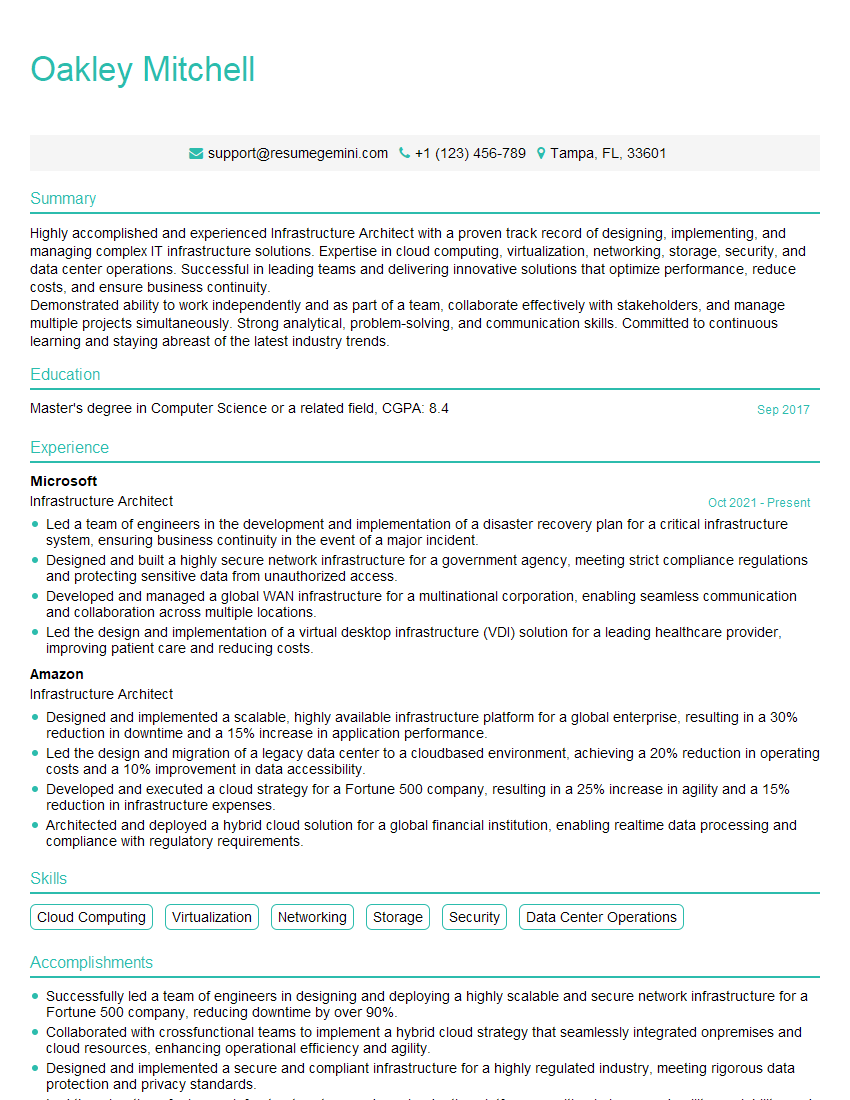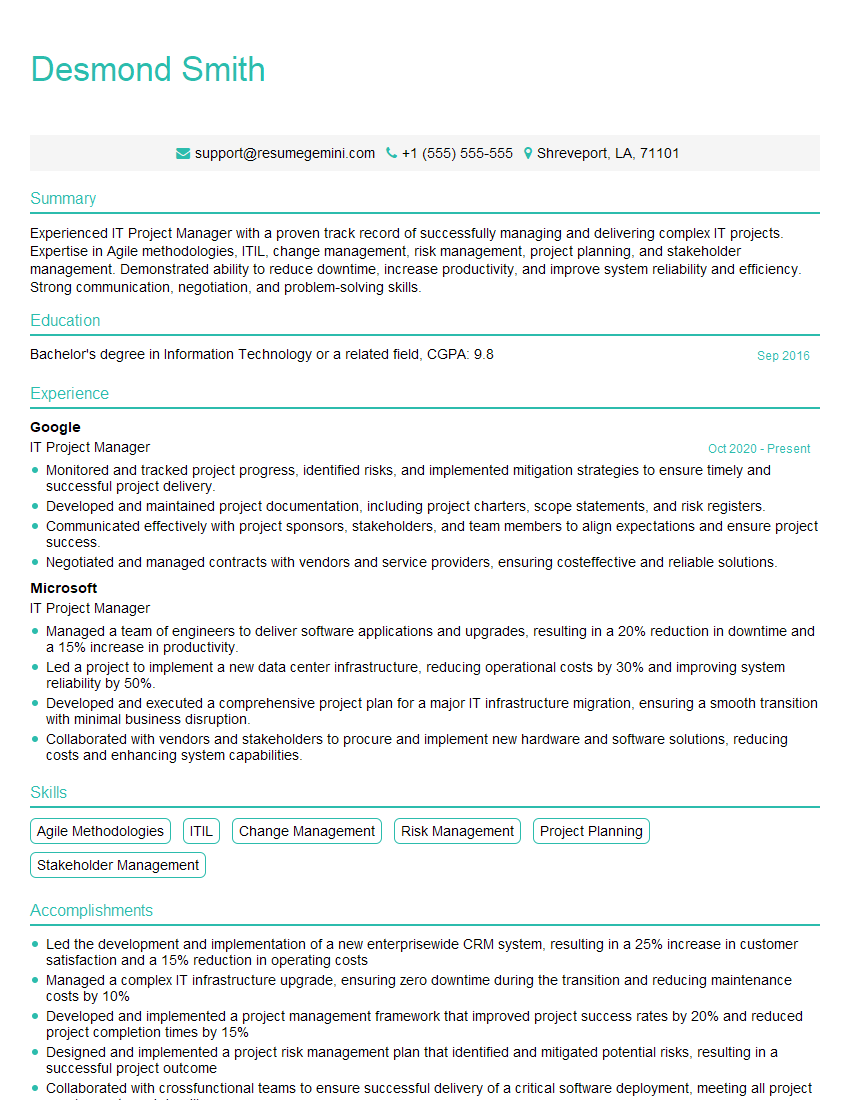Interviews are more than just a Q&A session—they’re a chance to prove your worth. This blog dives into essential Recovery Time Objective (RTO) and Recovery Point Objective (RPO) interview questions and expert tips to help you align your answers with what hiring managers are looking for. Start preparing to shine!
Questions Asked in Recovery Time Objective (RTO) and Recovery Point Objective (RPO) Interview
Q 1. Define RTO and RPO. What is the relationship between them?
RTO (Recovery Time Objective) defines the maximum acceptable downtime after a disaster or disruption before a system or application must be restored. Think of it as the acceptable window of system outage. RPO (Recovery Point Objective) defines the maximum acceptable data loss measured in time. It’s the point in time to which the system needs to be recovered. Imagine it as the acceptable data loss before restoration.
The relationship between RTO and RPO is intertwined. A lower RPO (less data loss) often necessitates a more robust recovery strategy, potentially leading to a higher RTO (longer recovery time). Conversely, prioritizing a low RTO (faster recovery) might mean accepting a slightly higher RPO (more data loss).
For example, if RPO is set to 1 hour, you should be able to restore your system to a point no older than 1 hour before the disaster. If RTO is 4 hours, then you must restore your system within 4 hours of the disaster. These values are determined based on the business impact of downtime and data loss.
Q 2. Explain the difference between RTO and RPO in the context of cloud vs. on-premise systems.
The difference between RTO and RPO in cloud vs. on-premise systems primarily lies in the availability of resources and recovery mechanisms. Cloud systems generally offer quicker recovery times and potentially lower RPOs due to features like replication, backups, and automated failover. On-premise systems might require more manual intervention, leading to potentially higher RTOs and RPOs.
For instance, a cloud-based application leveraging a geographically replicated database might have an RPO of just a few minutes and an RTO of under an hour, thanks to automatic failover to a redundant region. On the other hand, an on-premise system relying on tape backups might have an RPO of several hours or even days and an RTO of many hours depending on the time it takes to restore from tape and reconfigure the system.
Q 3. How do you determine an appropriate RTO and RPO for a given system or application?
Determining appropriate RTO and RPO values requires a thorough understanding of the system’s criticality and the potential business impact of downtime and data loss. This is usually accomplished through a Business Impact Analysis (BIA). This analysis involves identifying critical business functions, their dependencies, and the impact of their disruption on revenue, regulatory compliance, customer relationships, and other key factors.
The BIA provides a framework to categorize systems and applications based on their criticality. High-criticality systems demand lower RTO and RPO values, while less critical systems can tolerate longer recovery times and more data loss. For example, a financial transaction processing system will need very low RTO and RPO values compared to a less crucial internal communication system.
Consider also the technical feasibility. It’s crucial to assess the available technologies and resources to achieve the desired RTO and RPO. An unrealistic target will only lead to disappointment. For example, an older legacy system may limit what RTO and RPO are practically achievable.
Q 4. What factors influence the selection of RTO and RPO values?
Several factors influence the selection of RTO and RPO values:
- Business impact analysis (BIA): Determining the financial and operational consequences of downtime and data loss.
- System criticality: Classifying systems based on their importance to business operations.
- Recovery strategy: The methods available for data recovery and system restoration (e.g., backups, replication, failover).
- Technology capabilities: The performance and limitations of the infrastructure and software used.
- Regulatory compliance: Industry regulations or legal requirements regarding data retention and recovery times.
- Budget: The resources available to implement and maintain a robust recovery solution.
- Recovery environment: The infrastructure available for disaster recovery and business continuity, such as hot sites, warm sites or cold sites.
Q 5. Describe a scenario where a low RTO is crucial and a scenario where a low RPO is crucial.
Low RTO is crucial: Imagine a high-frequency trading firm. Even a few minutes of downtime can result in significant financial losses. In this scenario, a low RTO (e.g., minutes) is paramount, even if it means a slightly higher RPO (acceptable data loss).
Low RPO is crucial: Consider a hospital managing patient medical records. Losing even a small amount of recent patient data could have severe medical and legal repercussions. Therefore, a low RPO (e.g., a few seconds or minutes) is crucial, even if it results in a slightly higher RTO (acceptable recovery time).
Q 6. How can you reduce RTO and RPO values?
Reducing RTO and RPO values often involves a combination of strategies:
- Implementing robust backup and recovery systems: Frequent backups, utilizing faster storage media, and automated recovery procedures.
- Utilizing data replication techniques: Synchronizing data across multiple locations to ensure near real-time availability.
- Employing high-availability infrastructure: Utilizing redundant hardware, load balancing, and failover mechanisms to maintain system uptime.
- Investing in disaster recovery facilities: Having hot sites, warm sites, or cold sites ready to quickly restore operations in case of a disaster.
- Adopting cloud-based solutions: Leveraging cloud services for scalability, redundancy, and faster recovery times.
- Improving system monitoring and alerting: Proactive detection of potential issues to reduce downtime.
Q 7. What are the trade-offs between minimizing RTO and minimizing RPO?
Minimizing RTO and RPO involves trade-offs. Achieving very low RPOs (minimal data loss) usually requires more frequent backups, replication, and potentially more complex and costly infrastructure. This often translates to a more resource-intensive recovery process and potentially a higher RTO (longer recovery time). Conversely, focusing solely on low RTO (fast recovery) might involve accepting a higher RPO (more data loss), possibly relying on less frequent backups or a less sophisticated recovery system. The ideal balance depends on the specific needs and priorities of the organization, taking into account the criticality of the systems and the potential business consequences of downtime and data loss.
Q 8. Explain how RTO and RPO relate to business impact analysis (BIA).
A Business Impact Analysis (BIA) is the foundation for defining your Recovery Time Objective (RTO) and Recovery Point Objective (RPO). The BIA identifies critical business functions and assesses the potential impact of disruptions to those functions. This assessment helps determine the acceptable downtime (RTO) and data loss (RPO) for each function. For example, a BIA might reveal that an e-commerce platform’s downtime of more than 30 minutes will result in significant financial losses. This would lead to an RTO of 30 minutes or less. Similarly, the BIA might determine that losing more than an hour’s worth of transaction data would be unacceptable, resulting in an RPO of one hour or less.
Essentially, the BIA provides the context – the potential business consequences – that informs the setting of RTO and RPO targets. Without a BIA, choosing appropriate RTO and RPO values becomes arbitrary and potentially risky. The BIA ensures that recovery objectives are aligned with business priorities and risk tolerance.
Q 9. What are some common methods for achieving low RTO and RPO values?
Achieving low RTO and RPO values requires a multi-faceted approach focusing on both infrastructure and processes. Common methods include:
- Data replication and mirroring: Real-time or near real-time replication of data across multiple locations significantly reduces RPO. This could involve technologies like database mirroring, storage replication, or cloud-based solutions.
- High-availability infrastructure: Implementing redundant systems, load balancers, and failover mechanisms ensures continued operation even if a component fails. This directly impacts RTO.
- Cloud-based disaster recovery: Cloud platforms offer robust disaster recovery capabilities, including rapid provisioning of virtual machines and automated failover, contributing to lower RTO and RPO.
- Regular backups and robust backup strategies: Frequent, automated backups, stored in geographically diverse locations, are crucial for minimizing data loss (RPO). Employing various backup methods (e.g., incremental, differential) is also important for efficiency.
- Automation: Automating the recovery process through scripting and orchestration tools drastically reduces manual intervention time and thus lowers RTO.
The optimal strategy will depend on factors like budget, application criticality, and risk tolerance. For instance, a financial institution might require a very low RPO and RTO due to regulatory compliance and business needs, warranting significant investment in highly available and redundant infrastructure.
Q 10. Describe your experience in developing and implementing disaster recovery plans.
In my previous role at [Previous Company Name], I led the development and implementation of disaster recovery plans for several mission-critical applications. This involved:
- Conducting a thorough BIA to assess business impact and prioritize systems.
- Designing recovery strategies based on the RTO and RPO requirements identified in the BIA.
- Selecting appropriate technologies for data replication, high availability, and backup and recovery.
- Developing detailed recovery procedures and documenting them thoroughly.
- Training IT staff on the use of these procedures and conducting regular drills to test preparedness.
- Establishing clear communication protocols to ensure effective coordination during a disaster.
One specific project involved migrating a legacy application to a cloud-based platform to significantly improve RTO and RPO. The project included automating the failover process, resulting in a 90% reduction in downtime compared to the previous on-premises solution.
Q 11. How would you handle an unexpected outage that exceeds your defined RTO and RPO?
An unexpected outage exceeding defined RTO and RPO values requires a swift and decisive response, focusing on both immediate remediation and long-term improvement. My approach would involve:
- Activate the disaster recovery plan: Initiate the pre-defined procedures to restore services as quickly as possible.
- Communicate promptly: Inform stakeholders (clients, management, etc.) about the outage and the recovery efforts. Transparency is crucial during such situations.
- Investigate the root cause: Conduct a thorough post-incident review to determine the reasons for the extended outage. This is vital to prevent recurrence.
- Implement corrective actions: Based on the root cause analysis, put measures in place to prevent similar events. This might involve upgrades to infrastructure, enhanced monitoring, or changes to the disaster recovery plan itself.
- Document the event and lessons learned: This information is valuable for refining the plan and improving future responses.
A key aspect is to escalate the issue to appropriate levels of management as needed to secure the necessary resources and support for swift resolution. The goal is not only to recover but also to learn from the experience and improve the resilience of the entire system.
Q 12. What monitoring tools do you use to track RTO and RPO performance?
The specific monitoring tools vary depending on the technology stack and infrastructure. However, I regularly use a combination of tools to track RTO and RPO performance. These include:
- System monitoring tools (e.g., Nagios, Zabbix, Prometheus): Provide real-time visibility into system health, performance, and availability, helping to detect potential issues before they escalate into an outage.
- Backup monitoring tools (e.g., Veeam ONE, Commvault): Track backup status, success rates, and recovery times. Alerts are set up to notify of any failures or delays.
- Application performance monitoring (APM) tools (e.g., Dynatrace, New Relic): Monitor application-level performance metrics to detect bottlenecks or degradation, enabling proactive intervention.
- Log management and analysis tools (e.g., Splunk, ELK stack): Analyze logs to identify patterns, anomalies, and potential root causes of outages.
By integrating these tools, we obtain a holistic view of system performance and recovery capabilities, enabling proactive identification and mitigation of potential risks that could impact our RTO and RPO targets.
Q 13. Explain the concept of failover and failback in relation to RTO and RPO.
Failover and failback are critical mechanisms in disaster recovery, directly related to RTO and RPO.
Failover is the process of switching from a primary system to a secondary (backup) system in the event of a failure. The goal is to maintain business continuity with minimal disruption. The time it takes to complete a failover significantly impacts the RTO. A successful and rapid failover minimizes downtime and ensures a quick return to operations.
Failback is the process of switching back from the secondary system to the primary system once the primary system has been restored and is functioning correctly. The time it takes for failback is also relevant, though less critical than failover time. The completeness of data replication during the failover period impacts RPO. Successful failback ensures that the primary system is fully operational and that there is no significant data loss.
For example, a web application might failover to a secondary server hosted in a different data center during an outage at the primary data center. Once the primary data center is operational again, failback would restore the web application to its original location. The success of both processes directly correlates to minimizing the overall impact on the business, as measured by RTO and RPO.
Q 14. How do you test your disaster recovery plan to ensure it meets your RTO and RPO objectives?
Testing the disaster recovery plan is crucial to ensure it meets RTO and RPO objectives. We employ several testing methods:
- Tabletop exercises: These involve team discussions and walkthroughs of the recovery procedures. This method is cost-effective and allows for identification of gaps in planning or procedures.
- Functional tests: Partial or full-scale tests of recovery processes, typically simulating a specific failure scenario. These tests verify the functionality of the recovery systems and procedures. Measuring the time taken for recovery during these tests helps refine RTO targets.
- Full-scale disaster recovery drills: Involve a complete system shutdown and subsequent recovery to a secondary site. This is a more expensive and resource-intensive approach but is essential for validating the overall effectiveness of the plan, including verifying RPO and measuring actual RTO. This approach allows for identifying bottlenecks and refining the processes for improved efficiency.
After each test, a thorough post-incident review is conducted to analyze the results, identify areas for improvement, and update the plan accordingly. Regular testing, even at a smaller scale, is far better than relying on a plan that has never been tested and could fail under real-world conditions.
Q 15. What metrics do you use to measure the effectiveness of your disaster recovery plan?
Measuring the effectiveness of a disaster recovery plan centers around assessing how well it meets our predefined Recovery Time Objective (RTO) and Recovery Point Objective (RPO). We use several key metrics:
- RTO Achievement: This measures the actual time it took to restore systems and applications after a disaster, compared to the target RTO. A consistent RTO below the target indicates a robust plan. We track this using detailed recovery logs and timing data.
- RPO Achievement: This quantifies the amount of data loss experienced during a recovery. We compare the actual data loss to our target RPO. Tracking this involves analyzing backup schedules and recovery point validation.
- Recovery Success Rate: This metric tracks the percentage of successful recovery attempts. A high success rate demonstrates the plan’s reliability. We analyze failure rates and identify root causes for improvements.
- Mean Time To Recovery (MTTR): This measures the average time taken across multiple recovery exercises to restore systems. A lower MTTR suggests a more efficient and streamlined process.
- Post-Recovery Functionality Validation: We assess the functionality of restored systems to verify that they operate as intended. This includes verifying data integrity and application performance. This is documented through testing and verification reports.
- Exercise Frequency and Results: Regular disaster recovery exercises are crucial. We track the frequency and outcomes of these drills to identify areas for improvement and measure the team’s preparedness.
By analyzing these metrics, we can identify weaknesses in our disaster recovery plan and make data-driven improvements to enhance resilience.
Career Expert Tips:
- Ace those interviews! Prepare effectively by reviewing the Top 50 Most Common Interview Questions on ResumeGemini.
- Navigate your job search with confidence! Explore a wide range of Career Tips on ResumeGemini. Learn about common challenges and recommendations to overcome them.
- Craft the perfect resume! Master the Art of Resume Writing with ResumeGemini’s guide. Showcase your unique qualifications and achievements effectively.
- Don’t miss out on holiday savings! Build your dream resume with ResumeGemini’s ATS optimized templates.
Q 16. Describe a situation where you had to adjust RTO and RPO values due to changing business needs.
We recently experienced a situation where we had to adjust our RTO and RPO values for our e-commerce platform. Initially, our RTO was 4 hours and our RPO was 4 hours. This meant we aimed to restore the system within 4 hours and accept a maximum of 4 hours of data loss. However, the company underwent rapid expansion, and online sales became critical for our revenue stream. Any downtime started to cost us significantly more than before.
To reflect this increased business sensitivity, we decided to reduce our RTO to 1 hour and our RPO to 15 minutes. This required a significant investment in new technologies. We moved from basic tape backups to a highly available, cloud-based backup solution with near real-time replication. We also implemented a more robust failover system. This meant higher costs but significantly reduced our risk exposure and potential financial losses during outages.
Q 17. How do you communicate RTO and RPO to non-technical stakeholders?
Communicating RTO and RPO to non-technical stakeholders requires translating technical jargon into simple, understandable terms. Instead of focusing on minutes or hours, we use analogies:
- RTO: “Imagine our website going down. The RTO is the time it takes to get it back online. A lower RTO means less business interruption and less money lost.”
- RPO: “Think of our sales data. The RPO is how much of that data we could potentially lose in a disaster. A lower RPO means we lose less critical information like recent orders and customer details.”
We also explain the consequences of higher RTO and RPO values in business terms, focusing on potential revenue loss, reputational damage, and regulatory fines. Visual aids, like simple charts showing the cost of downtime, can further enhance understanding. We use clear and concise language, avoiding technical terms whenever possible and focusing on the impact on the business rather than the technical details.
Q 18. What are some common challenges encountered in setting and achieving RTO and RPO targets?
Setting and achieving RTO and RPO targets often presents challenges:
- Cost vs. Recovery Time/Data Loss: Achieving extremely low RTO and RPO values often requires significant investments in infrastructure, software, and expertise, making it a cost-sensitive balance.
- Complexity of Systems: Modern IT infrastructures are complex and interconnected. Coordinating the recovery of multiple systems simultaneously can be challenging.
- Data Volume and Backup Strategies: Large amounts of data require efficient backup and recovery strategies. Finding the right balance between frequency, storage, and recovery time can be complex.
- Testing and Validation: Regular disaster recovery exercises are crucial to validate the plan and identify weaknesses, which requires substantial time and resources.
- Lack of Skilled Personnel: Managing and executing disaster recovery plans requires specialized skills and knowledge, which can be a significant hurdle, particularly for smaller organizations.
- Third-Party Dependencies: Many organizations rely on third-party vendors for critical services. Coordinating recovery with these vendors can add complexity.
Overcoming these challenges requires careful planning, collaboration, and a commitment to investing in the necessary resources. Regular review and updates to the plan are essential for adaptability and effectiveness.
Q 19. What are the costs associated with achieving low RTO and RPO values?
Achieving low RTO and RPO values comes with significant costs:
- Hardware and Software Investments: This includes redundant systems, high-speed storage, advanced backup software, and specialized networking equipment.
- Cloud Services: Using cloud services for backup, disaster recovery, and failover can lead to recurring costs, depending on the chosen service level.
- Personnel Costs: Specialized IT staff are required to plan, implement, manage, and test the disaster recovery plan, as well as to carry out recovery procedures.
- Training and Certification: Training staff on the disaster recovery plan and associated technologies is essential.
- Consulting Fees: External consultants may be needed to assist with the design, implementation, and testing of a robust plan.
- Testing and Maintenance: Regular testing and validation of the disaster recovery plan require dedicated time and resources.
These costs need to be carefully balanced against the potential losses resulting from downtime and data loss. A cost-benefit analysis helps determine the optimal balance between investment and risk mitigation.
Q 20. How do you ensure compliance with industry regulations regarding data backup and recovery?
Ensuring compliance with industry regulations regarding data backup and recovery is crucial. Specific regulations vary depending on the industry and geographic location (e.g., HIPAA for healthcare, GDPR for Europe, PCI DSS for payment card information). Our compliance strategy involves:
- Understanding Applicable Regulations: We thoroughly research and understand all relevant regulations applicable to our business and data processing activities.
- Data Classification and Retention Policies: We establish clear data classification and retention policies to ensure compliance with data retention and deletion requirements.
- Regular Audits and Assessments: We conduct regular audits and assessments to verify compliance with data backup and recovery procedures and regulations.
- Documented Procedures: We maintain detailed documentation of our backup and recovery procedures, including roles, responsibilities, and processes.
- Security Measures: We implement robust security measures to protect backed-up data from unauthorized access, modification, or destruction.
- Vendor Management: If using third-party vendors for backup or recovery services, we ensure they comply with relevant regulations and have appropriate security measures in place.
- Incident Response Plan: A comprehensive incident response plan is necessary to address data breaches or other security incidents effectively.
Compliance is an ongoing process requiring continuous monitoring, adaptation to changing regulations, and proactive measures to mitigate risks.
Q 21. Explain how automation can improve RTO and RPO.
Automation significantly improves RTO and RPO by streamlining and accelerating the recovery process. Key areas of automation include:
- Automated Backups: Scheduled and automated backups ensure regular data protection, minimizing potential data loss. This reduces the RPO.
- Automated Failover and Failback: Automating the failover to disaster recovery systems minimizes downtime during an incident. This drastically improves RTO.
- Automated Recovery Procedures: Automating the recovery process, including database restoration, application restarts, and system configuration, ensures speed and accuracy. This speeds up recovery significantly, improving RTO.
- Automated Testing: Regular automated testing of disaster recovery plans allows for early detection and resolution of issues, enhancing reliability.
- Orchestration and Automation Tools: Using tools that can orchestrate and automate complex recovery procedures minimizes manual intervention and human error, leading to faster recovery.
For example, instead of manually restoring a database from a tape backup, we could use automated scripting and cloud-based storage to quickly and reliably restore it, dramatically reducing RTO. The use of automated systems also enhances the consistency and reliability of the recovery process.
Q 22. Discuss the importance of regular testing and reviews of disaster recovery plans.
Regular testing and review of disaster recovery plans are paramount. Think of it like a fire drill for your business’s data and systems. A plan sitting on a shelf is useless; it needs to be proven effective. Testing validates that your recovery procedures work as intended, identifying weaknesses and ensuring your RTO and RPO objectives are achievable.
- Tabletop Exercises: These simulate disaster scenarios without actually activating recovery systems. This allows for identifying potential bottlenecks and communication breakdowns in a safe environment.
- Functional Drills: These involve partially or fully activating your recovery systems. For example, restoring a critical database to a secondary location to verify its functionality and data integrity. This lets you test your RTO and RPO in a real-world environment.
- Full-Scale Drills: These simulate a complete site failure, testing all aspects of your disaster recovery plan. This is the most thorough but also the most disruptive test.
Regular reviews, ideally at least annually, are crucial to update the plan based on changes in infrastructure, applications, regulatory compliance, or personnel. These reviews incorporate lessons learned from past testing events and adapt the plan to evolving business needs.
Q 23. How do you ensure data integrity during recovery procedures?
Data integrity during recovery is crucial; recovering corrupted or incomplete data defeats the purpose of a disaster recovery plan. My approach involves a multi-layered strategy:
- Checksum Verification: Before and after recovery, I use checksums (e.g., MD5 or SHA-256) to verify data integrity. This ensures that the restored data matches the original data perfectly.
- Backup Verification: Regularly testing backups by restoring a sample of data to a test environment helps ensure the backups are valid and restorable. This proactive measure prevents surprises during a real recovery event.
- Version Control: Implementing version control systems (like Git) for configuration files and crucial data allows for easy rollback to previous, known-good states if issues arise during recovery.
- Data Encryption: Encrypting backups at rest and in transit safeguards sensitive data from unauthorized access, ensuring data confidentiality even in the event of a breach during a recovery process.
- Database Consistency Checks: For database systems, I conduct thorough database consistency checks after recovery to ensure that all indexes, relationships, and data are accurate.
For example, in one project, we implemented a three-tiered backup system with checksum verification at each layer. This allowed for quick and verifiable data recovery even after a complete server failure.
Q 24. What is your experience with different backup and recovery technologies?
My experience spans a wide range of backup and recovery technologies, including:
- Disk-based Backup Solutions: Technologies like Veeam, Commvault, and Unitrends for local and remote backups.
- Cloud-based Backup Solutions: AWS Backup, Azure Backup, and Google Cloud Backup, offering scalability, cost-effectiveness, and offsite redundancy.
- Tape-based Backup Solutions: While less common for primary backups now, tape still offers long-term archival and protection against ransomware.
- Replication Technologies: Asynchronous and synchronous replication solutions using technologies like DRBD (Distributed Replicated Block Device) and VMware vCenter Site Recovery Manager for near real-time data mirroring to secondary locations.
I’ve also worked with various recovery technologies, from bare-metal recovery to granular data restoration. The choice of technology depends greatly on the specific needs of the organization, considering factors like RTO, RPO, budget, and security requirements.
Q 25. Describe your approach to prioritizing systems and applications for disaster recovery.
Prioritizing systems for disaster recovery is critical to minimizing business disruption. I use a risk-based approach that considers:
- Business Impact Analysis (BIA): This identifies the critical systems and applications crucial for business continuity. We assess the potential financial and operational impact of downtime for each system.
- Recovery Time Objective (RTO): We define the maximum acceptable downtime for each system. Systems with short RTOs get higher priority.
- Recovery Point Objective (RPO): This defines the maximum acceptable data loss. Systems with low RPOs need more frequent backups and faster recovery mechanisms.
- Interdependencies: We map interdependencies between systems to ensure a holistic recovery plan that accounts for dependencies between applications.
For instance, a financial institution would prioritize payment processing systems over less critical applications. This tiered approach allows for focused effort and resource allocation where impact is highest. Using a BIA helps objectively set priorities.
Q 26. How do you manage the security aspects of disaster recovery and data backups?
Security is a core aspect of any disaster recovery plan. I incorporate several measures:
- Encryption: Data at rest and in transit must be encrypted to prevent unauthorized access during backup, storage, and recovery.
- Access Control: Strict access control measures ensure only authorized personnel can access backups and recovery systems.
- Security Audits: Regular security audits and penetration testing of backup and recovery systems identify vulnerabilities and ensure compliance with relevant security standards.
- Immutable Backups: Using immutable backups, which cannot be altered or deleted after creation, protects against ransomware attacks.
- Secure Offsite Storage: Storing backups offsite in a geographically diverse location ensures business continuity even in the event of a large-scale disaster.
This layered approach aims to protect both the confidentiality and integrity of your data throughout the entire disaster recovery process.
Q 27. How do you maintain documentation related to RTO and RPO?
Maintaining comprehensive and up-to-date documentation is essential for successful disaster recovery. I use a version-controlled documentation system (e.g., Confluence, SharePoint) that allows for easy collaboration and tracking of changes.
- RTO and RPO documentation: This clearly defines the RTO and RPO for each critical system. It includes justification for the targets, as well as testing methods and results.
- Recovery Procedures: Detailed step-by-step instructions for recovering each system, including contact information for key personnel.
- System Architecture Diagrams: Visual representations of the systems and their interdependencies aid understanding and problem-solving during recovery.
- Backup and Recovery Schedules: Documentation of backup schedules, retention policies, and storage locations.
- Testing Results: Comprehensive records of all disaster recovery testing activities, including findings and any necessary updates to the plan.
The documentation is regularly reviewed and updated to reflect changes in systems, applications, personnel, and best practices. A well-documented plan improves efficiency and reduces confusion during a crisis, which is crucial when time is of the essence.
Key Topics to Learn for Recovery Time Objective (RTO) and Recovery Point Objective (RPO) Interview
- Defining RTO and RPO: Understanding the core concepts, their differences, and how they relate to business continuity and disaster recovery.
- Calculating RTO and RPO: Methods for determining acceptable RTO and RPO values based on business impact analysis (BIA) and risk assessment.
- RTO and RPO in different recovery strategies: Exploring how RTO and RPO influence the selection of recovery strategies like hot site, cold site, warm site, and cloud-based solutions.
- Impact of RTO and RPO on system design: How these objectives affect infrastructure choices, data replication strategies, and application architecture.
- Practical Applications: Real-world examples of RTO and RPO implementation across various industries and business scenarios (e.g., finance, healthcare, e-commerce).
- Measuring and Monitoring RTO/RPO: Techniques for tracking performance against defined objectives and identifying areas for improvement in recovery processes.
- Relationship to other key metrics: Understanding how RTO and RPO relate to Mean Time To Recovery (MTTR), Mean Time Between Failures (MTBF), and other relevant performance indicators.
- Problem-solving scenarios: Preparing for discussions around challenges encountered during RTO/RPO implementation and strategies for overcoming them.
- Regulatory compliance: Understanding how RTO and RPO considerations align with industry regulations and compliance standards.
Next Steps
Mastering RTO and RPO is crucial for career advancement in IT and related fields. A strong understanding of these concepts demonstrates your expertise in disaster recovery planning and business continuity, making you a highly valuable asset to any organization. To increase your job prospects, focus on crafting an ATS-friendly resume that clearly highlights your skills and experience. ResumeGemini is a trusted resource to help you build a professional and impactful resume. Examples of resumes tailored to showcasing Recovery Time Objective (RTO) and Recovery Point Objective (RPO) expertise are provided to guide you. Use these resources to present yourself effectively and land your dream job!
Explore more articles
Users Rating of Our Blogs
Share Your Experience
We value your feedback! Please rate our content and share your thoughts (optional).
What Readers Say About Our Blog
Hello,
We found issues with your domain’s email setup that may be sending your messages to spam or blocking them completely. InboxShield Mini shows you how to fix it in minutes — no tech skills required.
Scan your domain now for details: https://inboxshield-mini.com/
— Adam @ InboxShield Mini
Reply STOP to unsubscribe
Hi, are you owner of interviewgemini.com? What if I told you I could help you find extra time in your schedule, reconnect with leads you didn’t even realize you missed, and bring in more “I want to work with you” conversations, without increasing your ad spend or hiring a full-time employee?
All with a flexible, budget-friendly service that could easily pay for itself. Sounds good?
Would it be nice to jump on a quick 10-minute call so I can show you exactly how we make this work?
Best,
Hapei
Marketing Director
Hey, I know you’re the owner of interviewgemini.com. I’ll be quick.
Fundraising for your business is tough and time-consuming. We make it easier by guaranteeing two private investor meetings each month, for six months. No demos, no pitch events – just direct introductions to active investors matched to your startup.
If youR17;re raising, this could help you build real momentum. Want me to send more info?
Hi, I represent an SEO company that specialises in getting you AI citations and higher rankings on Google. I’d like to offer you a 100% free SEO audit for your website. Would you be interested?
Hi, I represent an SEO company that specialises in getting you AI citations and higher rankings on Google. I’d like to offer you a 100% free SEO audit for your website. Would you be interested?
good
